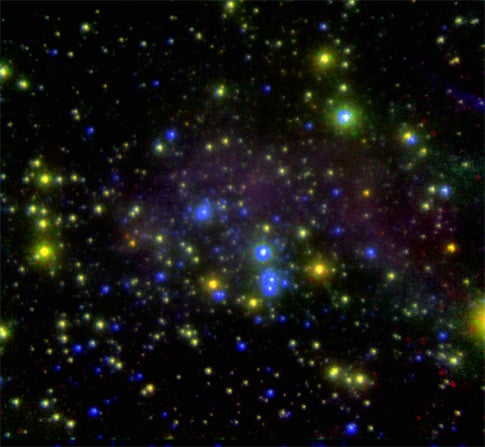Edwin Hubble once called IC 10 “one of the most curious objects in the sky,” and new observations of the extremely faint, lightweight dwarf galaxy are giving scientists new clues about how populations of stars are born.
Though the properties of stars is one of the most well-studied topics in astronomy, scientists still don’t fully understand all the mechanisms involved in star formation and evolution, particularly in galaxies with low levels of oxygen, nitrogen and other heavy elements. But scientists studying the IC 10 galaxy may soon understand how stars might have looked like in the distant past, when the universe was in a younger, more pristine form.
“A few years ago these types of studies would have been impossible from the ground,” said Taft Armandroff, director of the W. M. Keck Observatory, whose own research includes the study of dwarf galaxies. “We can now study individual stars of galaxies several million light years from Earth to understand how star formation events may have affected the evolution of the Milky Way galaxy. This galaxy can teach us what the most common types of galaxies in the universe might be like.”
New images of IC 10 reveal a small region of space teeming with nearly a thousand stars. The image, obtained with NASA’s Hubble Space Telescope and the W. M. Keck Observatory in Hawaii, shows evidence of a vigorous star formation event that took place within the last 10 million years.
William Vacca at the NASA Ames Research Center led the study and says IC 10 may answer many unresolved questions about stellar evolution. “IC 10 is a remarkable galaxy,” he said. “It is the only one we’ve seen that falls outside an established pattern of having a certain number of massive nitrogen-type stars for each carbon-type star. This imbalance has caused us to wonder if our past conclusions about massive stars have been correct. Do we need to revise the models of stellar evolution?”
Astronomers have known that IC 10 has more giant, rare stars called “Wolf-Rayet stars” than all other nearby dwarf galaxies combined. Wolf-Rayet stars are extremely hot blue stars losing enormous amounts of mass to the interstellar medium. In addition, the proportion of Wolf-Rayet stars in IC 10 seems to be wildly out of balance. For the number of stars containing carbon, astronomers expected to see a certain number containing nitrogen.
But so far, very few nitrogen stars have been found. Could IC 10 be hiding a population of stars?
Using a combination of Hubble and Keck telescope images, Vacca’s team found many previously undiscovered stars in the IC 10 galaxy. Each new star can now be measured to determine its chemical composition. If the newly found stars contain nitrogen, then part of the “missing nitrogen” puzzle might be solved.
“The combination of HST images in the optical and Keck Laser Guide Star images in the infrared has been a major breakthrough in our understanding of dense stellar regions,” said Dr. Graham. “IC 10 has so many stars in such a tiny region of space that ground-based studies have been confused. But the combination of HST and Keck has been revolutionary in our understanding of this object, and for any object with a dense region of stars.”
The new images of IC 10 are centered on a bright star first thought to possibly be the most luminous Wolf-Rayet star in IC 10. Follow up studies then found the star to be comprised of at least three or more components.
Now, new data from Keck show the bright star ([MAC92] 24) is actually six or more stars, perhaps even a cluster of stars.
“This is the first time this sort of study has been done using adaptive optics,” said co-author Chris Sheehy of the University of Chicago. “It gives us the ability to make these kinds of measurements accurately from the ground and there’s no shortage of targets in need of a fresh look. The potential is exciting.”
The new data has also enabled scientists to measure the precise distance to IC 10, a figure that has eluded scientists since the object’s discovery more than 100 years ago. Dr. Vacca and his collaborators calculated the distance to IC 10 to be about 2.4 million light years from Earth, or 750 kiloparsecs. This is in good agreement with some previous estimates.
IC 10 was first discovered by Lewis Swift in 1889 at the Warner Observatory in Rochester, New York. The “Index Catalogue” (IC) is a catalogue of galaxies, nebulae and star clusters that supplements the more modern New General Catalogue (NGC). First published in 1895, the catalogue first described IC 10 as a “faint star involved in extremely faint and very large nebula.” It wasn’t until 1935 that IC 10 was first proposed as an extragalactic object and Edwin Hubble later proposed IC 10 might be a member of the Local Group. It took another 30 years before these suspicions could be confirmed using radial velocity and distance measurements.
Astronomers now know IC 10 is similar in many ways to the Large Magellenic Cloud of the Southern Hemisphere. But unlike the Large Magellenic Cloud, IC 10 orbits Andromeda, not the Milky Way. The study of IC 10 is giving astronomers a picture of what the Milky Way might have looked like billions of years ago before the galaxy’s interstellar medium was enriched with elements such as oxygen and nitrogen.
The paper, “Imaging of the Stellar Population of IC 10 with Laser Guide Star Adaptive Optics and the Hubble Space Telescope,” was published in the June 10 issue of Astrophysical Journal. The research was made possible with grants provided by the National Science Foundation and NASA.










